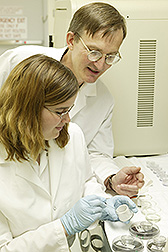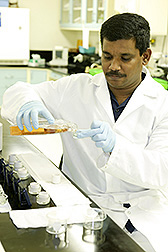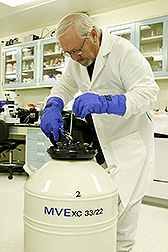Frozen Flies Safeguard Research, Screwworm Eradication Efforts |
|
 To prepare screwworm eggs for penetration by a cryoprotectant, entomologist Dennis Berkebile and technician Staci Bohling remove the eggs' outer layer. (D015-1) |
Using cryopreservation techniques, ARS entomologists can now freeze screwworm fly embryos—to later thaw and rear them to adulthood. The advance should cut the costs of maintaining fly colonies for research or of programs using the sterile-insect technique. Considered the backbone of screwworm eradication, sterile-insect releases have helped eliminate this parasitic fly species from the United States and Central America as far south as the Isthmus of Panama. In the approach, both male and female screwworms are reared under factorylike conditions and then sterilized by irradiation. The sterile insects are then released to mate with wild flies, resulting in no progeny. Eventually, the fly population collapses. (See "Squeezing Out Screwworm," Agricultural Research, April 2001, pp. 18-22.) "Freezing embryos eliminates the need to continuously rear flies used in research or held in reserve as backup strains for the mass-rearing and release program. This is costly, especially if there's no immediate need for them," notes Roger Leopold, an entomologist with the Insect Genetics and Biochemistry Research Unit at ARS's Red River Valley Agricultural Research Center, Fargo, North Dakota. Leopold's efforts to cryopreserve fly embryos first began there in the mid-1980s, "but it didn't really get going until the early 1990s," he says. That's when he consistently began reviving frozen embryos of house flies and other species. |
 While visiting the Midwest Livestock Insects Research Unit in Lincoln, Nebraska, postdoctoral researcher Arun Rajamohan (from Fargo) prepares screwworm embryos with a cryoprotectant before storage. (D014-1) |
Around 1996, he teamed up with Dennis Berkebile, an entomologist specializing in screwworm genetics at ARS's Midwest Livestock Insects Research Unit, Lincoln, Nebraska. Along with two other collaborators—Harvey Blackburn, an animal geneticist at ARS's National Center for Genetic Resources Preservation, Fort Collins, Colorado; and Arun Rajamohan, a postdoctoral researcher at North Dakota State University—Leopold and Berkebile explored creating an embryo-based repository to back up colonies of 10 key screwworm strains. Up until August 2004, these strains were kept at ARS's Lincoln site and the screwworm mass-rearing plant in Tuxtla Gutierrez, Mexico. (In August, the Lincoln unit concluded its screwworm program with the transfer of some of its last remaining colonies and biocontainment equipment to a new facility being built in Panama.) According to Berkebile, some of the Lincoln colonies date back 20 years and include strains with useful mutations, including colored eyes and curly wing deformities. Scientists prize such mutations because they can serve as markers to important genetic traits, like fitness, and can be used to create all-male strains of screwworm with potential to cut fly-rearing costs. Such strains could prove useful if screwworm eradication expands into South America and the Caribbean. |
 In Lincoln, Nebraska, visiting entomologist Roger Leopold (from Fargo) places screwworm embryos in a liquid-nitrogen storage unit to be transported to the germplasm unit in Fort Collins, Colorado. (D013-1) |
Berkebile says creating a repository addressed fears of losing the strains to calamities such as disease outbreaks, fire, or even earthquake damage to facilities in which the flies are kept—derailing years of research in support of programs to eradicate the parasite and prevent its reintroduction. "The idea behind using cryopreservation was that we'd be able to preserve genetic material encoded within the embryos' DNA," says Berkebile. "So, if something were to happen to the strains they're mass-producing in Mexico, for example, we'd have these strains in storage to bring back and start the colonies all over again." The alternative would be to capture wild flies in field traps, screen them, and breed them in hopes they would be genetically similar to the lost strain. Embryo cryopreservation also offers a way to safeguard against unwelcome mutations and inadvertent selection. Both events can change a colony's unique genetic makeup, rendering it less useful to research or sterile-insect applications. "If there are any genetic changes (either positive or negative) in the live populations, we would have the original genetic material to refer to in evaluating that change," says Blackburn, who leads the Fort Collins center's National Animal Germplasm Program. "Having a genetic repository for insects would allow breeders to determine what genes may have been lost in the selection process." So why not freeze adult flies, rather than the embryos, and thaw them out as needed? Because embryos lack a cuticle—the outer covering of an insect that protects it from water loss and environmental elements. This makes it possible for scientists to extract water from the embryo and replace it with a cryoprotectant like ethylene glycol, which prevents the embryo's 40,000 to 50,000 cells from being damaged by ice crystals during freezing. "We're working with an insect stage that's comparable to a 7-month-old mammalian fetus—if you consider the stage of differentiation of the cells and organs," Leopold explains. Differentiation is the process whereby cells begin to form specific tissues and organs. Even with embryos, he adds, "Cryopreservation at this stage of differentiation is usually very difficult." The process begins with collecting eggs soon after they're deposited by caged female flies. The eggs are incubated to the correct developmental stage; loaded with the cryoprotectant, which eliminates most of the cell water; and then "vitrified," meaning they are cooled so rapidly that the cryoprotectant and any remaining water turn to a glass rather than to ice crystals. The scientists then plunge the embryos into liquid nitrogen (-196°C) and store the vitrified eggs in metal cassettes within a tank of liquid nitrogen. According to Leopold, the eggs can be stored there indefinitely at a cost of pennies per day. Depending on the number of strains in culture, maintaining live caged colonies, by comparison, can cost thousands of dollars per month. To revive the embryos, scientists remove the cassettes from liquid nitrogen, hold them in nitrogen vapor for a short time, and then immerse the embryos in fetal bovine serum, which removes the cryoprotectant. Thirty to 45 minutes later, the embryos begin moving within the eggs. About 8 to 12 hours later, they hatch as larvae. The hatchlings are then reared on an artificial diet of dried blood, egg, milk, and other ingredients that simulate their natural diet of animal flesh. So far, the longest the scientists have stored the cryopreserved eggs is just over 1 year. But Leopold reckons these eggs, like embryos of other animals currently in storage, can last indefinitely in their frozen state. When he and Berkebile first tried this technique on two screwworm strains, about 30 to 40 percent of the eggs hatched after being frozen. Now, oftentimes 70 to 80 percent hatch, with 30 to 60 percent of the larvae developing into adult flies. The researchers expect to bolster that rate with a new, improved diet that they devised for recovering cryopreserved larvae. Meanwhile, they've also begun storing cryopreserved embryos inside tanks at ARS's Fort Collins germplasm unit. Over the next couple years, they'll monitor the embryos' viability and use revived specimens to check for genetic changes in live colonies. Historically, the focus of ARS's National Center for Genetic Resources Preservation has been to preserve germplasm from plants in the form of seeds or pollen. The focus has recently been expanded to include livestock and aquatic germplasm as frozen sperm and embryos. "We see potential for expanding the program to include cryopreservation and conservation of insect genetic resources," says Blackburn. "For example, we've already had discussions with several labs about cryopreserving bee semen. Clearly, the spectrum is limitless for both harmful and beneficial insects."—By Jan Suszkiw, Agricultural Research Service Information Staff. This research is part of Veterinary, Medical, and Urban Entomology, an ARS National Program (#104) described on the World Wide Web at www.nps.ars.usda.gov. To reach scientists mentioned in this story, contact Jan Suszkiw, USDA-ARS Information Staff, 5601 Sunnyside Ave., Beltsville, MD 20705-5129; phone (301) 504-1630, fax (301) 504-1641. "Frozen Flies Safeguard Research, Screwworm Eradication Efforts" was published in the February 2005 issue of Agricultural Research magazine.
|






